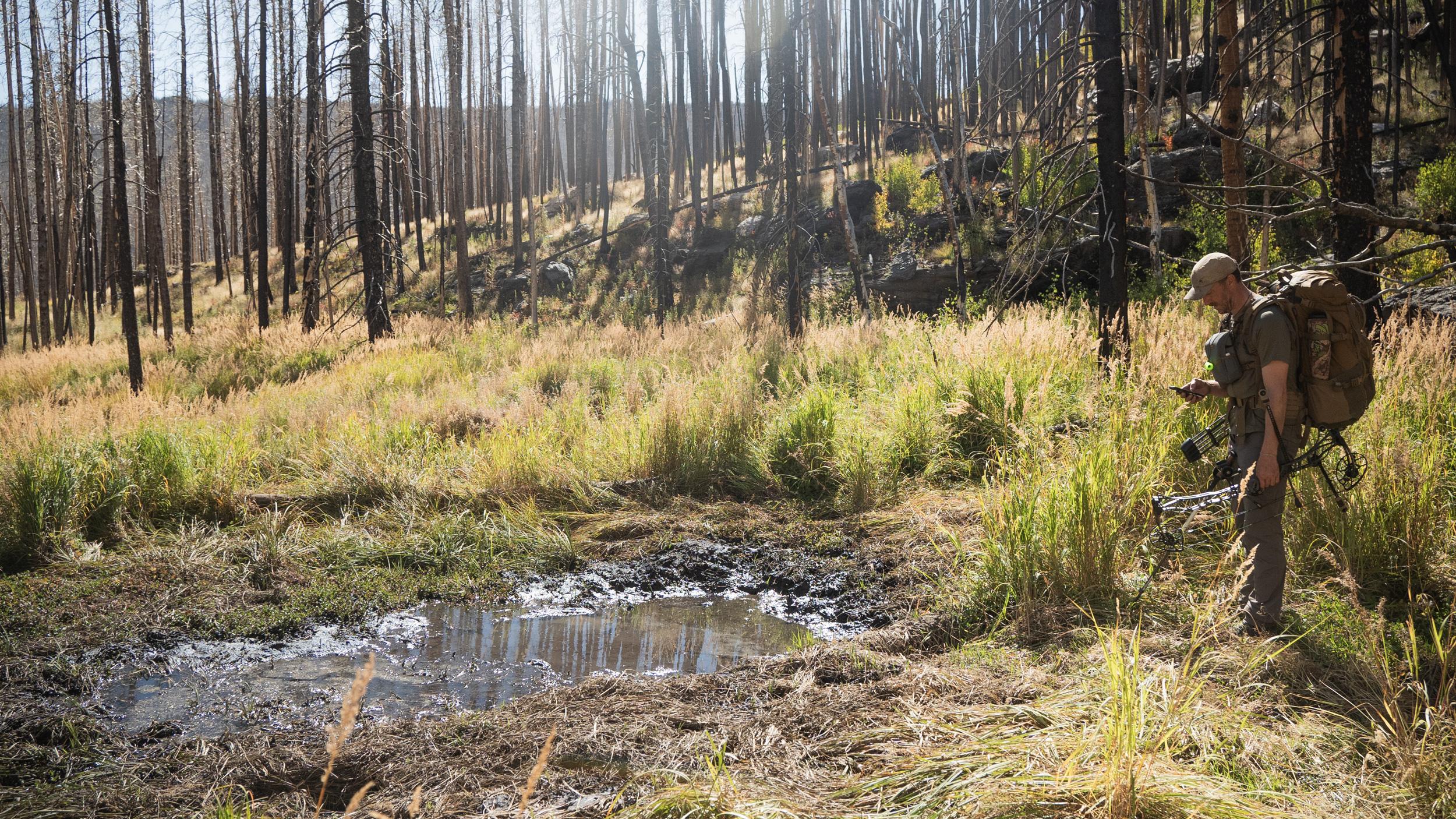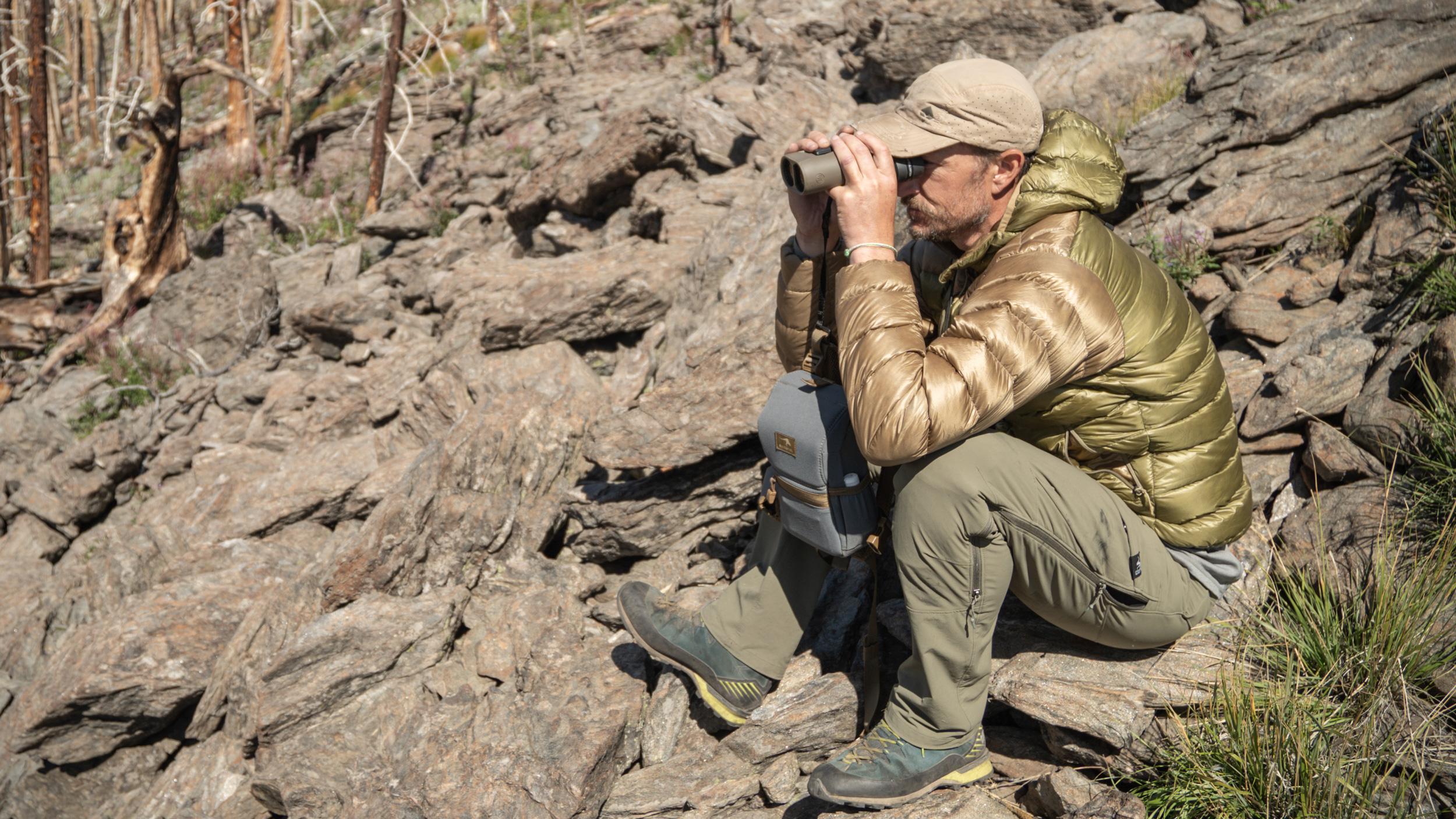





Glassing for elk with SIG SAUER ZULU6 image-stabilized binoculars.
Elk are relatively simple in regards to their requirements to survive, and it’s commonly stated that there are three pillars for good habitat: food, water, and cover. I might add a fourth, which would be hunting pressure and how elk react to it.
In order to find elk, the key is to know where they are most likely to live. Depending on the time of year that you’re hunting, the locations you find elk will vary. For this article, I’m going to primarily approach it from a September archery perspective.
Once you move into the last couple weeks of October, it seems that there’s a transitional period where mature bulls are moving into more secluded pockets of good feed and cover where they are less likely to be pressured. During the late hunts from November and even later, bulls may be occupying south facing slopes more readily and ridgelines where they can find feed and get some warmth from the sun to ward off the cold season temperatures. These statements are generalities and depend on the weather; however, throughout much of the central and more northern states, it’s a great starting spot.
With that, let's dive into September archery elk.
Bedding areas are critical for elk and archery elk hunters. In many cases, bedding habitat may be the most important. If you think about a typical archery elk hunting scenario, bowhunters are trying to find elk in the morning hours when rutting bulls and cows are feeding and working their way toward a bedding area. In my experience, it’s common that a herd bull with cows will not initially leave his harem and come back to challenge another bull or inspect to see if he’s lost a cow. Over the years, I’ve had good success remaining within earshot of a moving herd during the morning hours until late in the morning when they’re settling into a bedding area. As the herd slows or enters their bedding area and feels more secure, a herd bull is more likely to come back to check out another bull or search for a lost cow. In mid-afternoon, I regularly hear bulls get up from their bed and bugle a few times to test the pulse of other elk in the area, and even later in the day, the whole herd will get up to feed. They may also begin to move towards water, which they will hit either just before or after dark. The point being: bedding areas are important to helping you get close to bull elk. But what makes a good bedding habitat?
Elk need shade during the warmer months of August and September. A bull elk is a big animal with a thick hide, and in order to thrive, they need cooler temperatures to regulate body temperature. Shady, cooler slopes are preferred for bedding during the archery season. North facing slopes are cooler, wetter, and typically composed of dense evergreen timber.
East facing slopes offer some sun early in the day, but shade out sooner in the afternoon. In most cases, during the archery season, elk are bedding on north, northeast or east facing slopes that have the vegetation to offer long-term shade. It’s not to say that they’ll never bed on a south or west facing slope, but it’s far less likely. Elk seem to gravitate towards dense lodgepole, mixed spruce and fir forests. I’ve also seen them bed in thick stands of regenerating aspen several years after a wildfire. Old growth aspen stands produce good feed in the understory, but are less desirable for bedding. Elk will also regularly bed in blowdown and deadfall zones where there is good shade and security.
To drill down further, mid-elevation benches and flats on a slope make great elk bedding habitat. Herds of elk prefer milder slopes to bed, perhaps in the 10- to 20-degree range. They often bed on a bench just below the crest of a ridge or a peak, which offers them good wind detection and escape over the ridge. Escape routes are worth noting: elk like areas where they can easily dive off into a remote canyon, up and over a ridge, or into thick vegetation or blowdown to evade predators easily. The prevailing wind and thermals can further dictate where elk are most likely to bed. Two points to consider are early morning and late evening timeframes when the thermals move down slope. During late morning, noon, and afternoon hours while the sun is warming the slope, the thermals will move uphill. In addition, where you may have prevailing winds, elk often bed so they can monitor both for danger. The normal pattern for elk is that they will move up a slope in the morning with the thermals in their face. Early in the mid-afternoon/evening hours, they will regularly feed downhill, once again with the wind in their face. Elk utilize the wind to help them avoid predation, and their bedding areas are selected to give them a good advantage. Lastly, a good bedding area is close to good feed and water. However, elk will travel for miles for both feed and water if they are pressured, so this is less of a determining factor. Lastly, hunting pressure is a consideration. The best bedding area in the world won’t hold elk if there is ample hunting pressure. If the area is easily reached, glassed from a roa,d or just generally highly pressured, it’s not going to hold elk.
Elk need water. During the summer months and through the September and early October rut, it becomes even more important. A mature bull can require two to five gallons of water per day, depending on temperature and forage moisture. During the rut, when temperatures are hot and dry, water will influence an elk’s daily patterns. If the weather is dry and relatively warm, elk will have to go to water every single day. Water sources that are close to feeding and bedding areas are preferred, but, once again, elk will travel for water if they have to because of hunting pressure. Elk will seek out creeks, streams, or rivers; however, in my experience, they seem to gravitate towards seeps, springs, or standing water in small catchments or ponds. I believe that it’s in part the minerals and deposits associated with standing water, and that they can probably hear and see better while watering from a stationary source.
In addition to drinking water, bulls will utilize seeps and springs to wallow in. A wallow is essentially a water/mud source that bulls will use during the rut to cool down and scent-mark. Wallows are mostly established during the first part of September as bulls are covering ground in search of cows, but I have observed and killed bulls while ambush hunting on wallows throughout the first three weeks of September. They are creating a walking scent trail to advertise themselves as a bull on the lookout for cows. To scout for water sources, I use our GOHUNT Maps in 3D mode.
I’m primarily looking for isolated water tanks in arid terrain, hidden springs, seeps, and wallows. The historical imagery tool in both mapping platforms can be very helpful to analyze each water source, and, in many cases, I can see if there’s a wallow established. If I can find water sources in close proximity to mid slope benches in a shady north or eastern facing slope, it’s a good indication that elk will probably be using those. I’ve observed elk watering from 6:00 a.m. to 9:00 a.m. before feeding or just after feeding as they approach bedding areas. During the midday hours, a bull will often get up and sneak away from his bedded cows to wallow and water. One of the best times to hunt a water/wallow is in the evening hours from about 5:00 p.m. to 8:00 p.m. Herds will get up in the afternoon and feed towards water sources and regularly water just before or after dark.
Overall, elk need water every day during September. They prefer springs, seeps or water catchments like ponds. Wallows are a key component for bull elk during the pre-rut and rut. To find likely water sources, use aerial imagery on GOHUNT Maps in combination with the water layer. Finally, keep in mind that seeps and springs within or close to bedding areas are ideal.
Elk are more opportunistic feeders with a wider range of food sources that they can consume to survive when compared to a mule deer. During the summer months — and even into September — they are primarily consuming grasses, forbs (broadleaf plants) and new growth. As grasses cure, they will gravitate more towards a mix of grasses and shrubs like serviceberry and snowberry. While we’ve all seen classic elk terrain in movies and magazines, it’s rare to see elk out feeding freely in big open green meadows during the September hunting seasons. At that time of year, they feed more in isolated pockets or micro meadows located near bedding areas. When I’m evaluating maps or looking at a landscape, I’m looking for a “mosaic.” What I mean by that is I’m looking for areas that are broken with a mix of small pockets of feed and cover. I often use the word “edge” when referring to feeding areas. Elk like the edges of cover to feed. They also like areas that offer both a good understory of feed and cover. That can be provided through disturbances like fire or beetle kill. In those cases, the disturbance will have opened up the canopy, allowing sunlight to reach the forest floor and will generate new growth while the standing dead trees provide cover. Some of the best elk habitat can be found in new burns (one to five) years old or in beetle-killed pine forests. In those areas, elk have cover, new green feed, and often, water sources will have emerged since the trees are no longer pulling water from the ground. However, jackstraw downed trees can be very hard to navigate and hunt, but it does provide great elk habitat. Elk feed heavily for one to two hours after sunrise before moving to bed and about one to two hours in the evenings before dark. Feeding areas are often adjacent or below bedding areas. Once again, an elk's primary means of defense is its nose, so they will bed and feed where they can use the thermals and prevailing winds to reach those feeding areas safely.
When I think about a mule deer buck, I know it will avoid hunting pressure by becoming nocturnal or adjusting his bedding and feeding areas ever so slightly to avoid being detected. He may slip onto the backside of a ridge or move up or down the canyon slightly. Elk are not the same. Elk will move miles away from pressure, and they can do so because they can survive on a wider arrangement of feed. They are a bigger animal, they move more easily across the landscape, and seem to be content to avoid hunting pressure by just moving into entirely new drainage and terrain. So, is the most remote elk habitat the best? The answer to that is, to some extent, yes. More remote, quality habitat will be more productive, but that’s not to suggest that more accessible terrain can not also hold elk. It really boils down to where people are hunting, and most hunters are prone to using the same trailheads, trails, and roads. There’s really no silver bullet to avoid other hunting pressure, but here are some commonalities to areas or factors that often yield less hunting pressure.
Hunting weekdays rather than weekends will often result in lower hunting pressure. Most bowhunters are willing to backpack hunt or day hunt anywhere from three to five miles from their jump off point, but there are fewer willing to hunt over six miles away from their rig. Before I leave, I’ll glass and listen for pressure before committing. I might glass trailheads, roads, and visible main ridges for other hunters. In most cases, I can find aerial imagery during the month of September, so I can look to see where the vehicles are on the landscape and how many.
There are also often good hunt areas closer to access points, but those might be the steeper blowdown or thick portions of timber that are harder to get into and hunt. Typically, when I hunt a new area and I’m covering ground, I’ll take note of where I’m seeing other hunters and how far they are from the trailhead. In many cases, they are mostly hunting in that three to five mile range, leaving the closer quality areas and the areas even deeper into the backcountry more untouched. Additionally, I might suggest thinking about barriers to accessing good areas. If there’s a river crossing that limits most people or if there’s public land on the backside of private land that’s difficult to access, those areas are generally much less pressured. Don’t overlook tiny basins or benches that most people glass past on their way to the more traditional looking basin and bowls.
One of my favorite ways to avoid hunting pressure and find elk is to stay mobile and hunt across the landscape, either by backpacking or in my vehicle. Far too many hunters get married to their plan or their spot that has produced in the past. If you aren’t finding elk or if you aren’t finding bulls that you have a high percentage of killing, move. In some instances, there will be elk in an area even though there’s a good amount of hunting pressure. In those situations, the bulls may bugle less, only randomly calling very early in the morning or evening. They may only bugle after dark. You may see bulls moving to heavy cover earlier or onto private lands or inaccessible areas. All of these can be signs of high hunting pressure, and in those cases, we have to decide to go find less pressured, more killable elk or hunt them differently. Elk hunting with a bow is a lot like a chess game; you have to be able to evaluate the elk behavior, the terrain, and the other hunting pressure to see where you can ultimately get within range of a bull and kill it.
The information shared above will hopefully help you find good areas to hunt elk. Beyond knowing where elk are most likely going to be, there is the actual “finding” elk on the landscape. I have said it before, but I think glassing is underutilized by most archery elk hunters. I recall a hunt a few years ago when I hunted a new area that I’d never been to. The first morning, I climbed to a high point in the area that was approximately three miles in and spent that first half of the day glassing a giant swath of country. That glassing session told me the distance most other hunters were willing to backpack in, and I was able to see three large herds of elk. I made note of where each herd was and, more importantly, what type of terrain they were living in, including the elevation, the slope, and the vegetation. I learned most of what I would need to find success a few days later just by spending a half day glassing from a great vantage point.
Blind calling can be effective as well. I know several very successful archery elk hunters who cover great terrain day in and day out bugling and cow calling for elk and listening for a response. Night time bugling can be very effective in helping you locate herds. Night bugling from access roads and trails can be a great way to find elk that are holing up in pockets close to roads that other hunters are overlooking.
Overall, if you do your homework prior to leaving, make a plan, and then be adaptable and think like an elk when you get there, you’ll find elk and give yourself a great chance to kill one. Like I said, elk are a relatively simple animal…they need food, water, cover for bedding, and relief from pressure. As you evaluate the landscape, keep those in the forefront of your mind, and you’ll find elk.